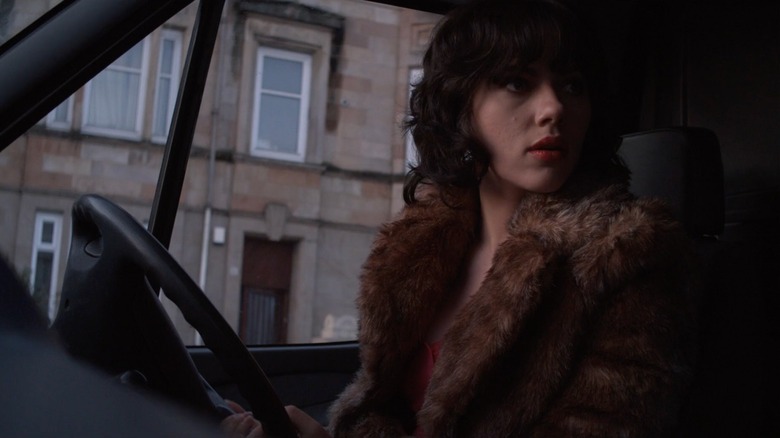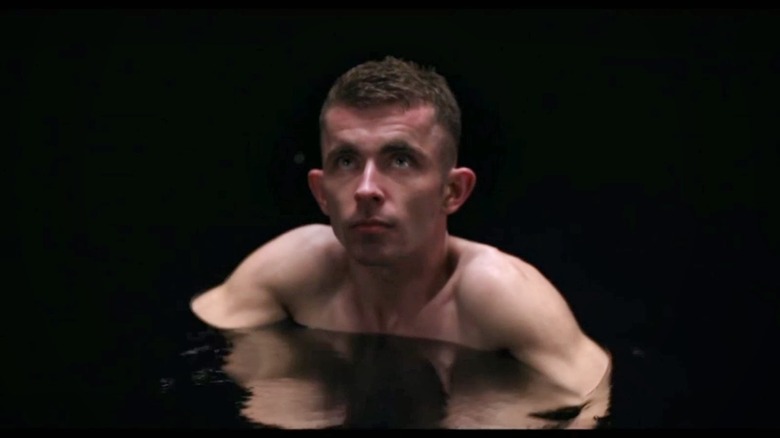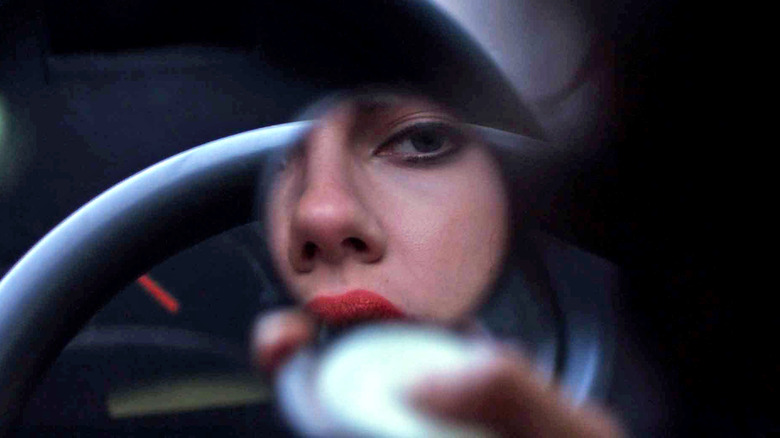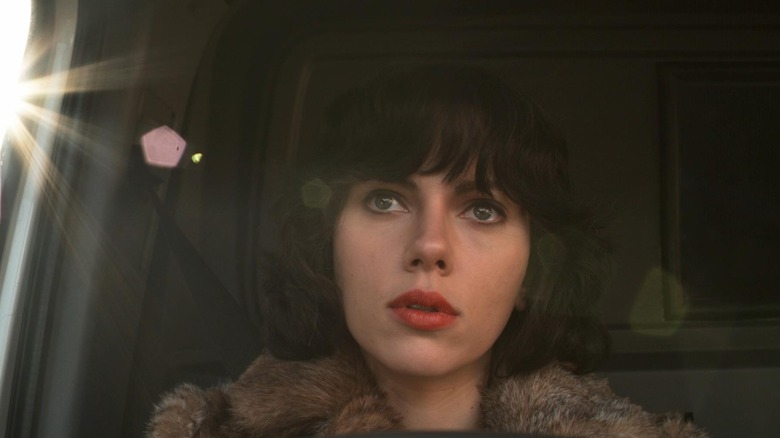Why It Took Jonathan Glazer A Decade To Make Under The Skin
Jonathan Glazer isn't exactly the most prolific director. Terence Malick, who famously took a 20-year break between "Days of Heaven" and "The Thin Red Line," is churning them out these days compared to him. Just three movies in 22 years have added an air of mystery to the idiosyncratic director. When will he strike next? What will it look like? For among that canon of three of the most distinctive films of the 21st century, no two are alike.
Having carved out his name with some of the most iconic adverts and music videos of the '90s, Glazer made his debut with the off-kilter crime flick "Sexy Beast." With the unforgettable sights of Ray Winstone in a pair of yellow budgie-smugglers, a killer rabbit with an uzi, and Ben Kingsley as a bald nutjob, it became an instant cult classic.
Glazer wasn't about to do a Guy Ritchie and just knock out more of the same. He followed his sun-kissed, c-bomb laden debut with the moody and peculiar "Birth," a film so different in tone, style, and pace that it's hard to believe it came from the same director.
Nine years would pass between that and his third feature, "Under the Skin," and Glazer shifted gears again. This time he delivered a hypnotic meditation on what it means to be human from the perspective of a predatory alien. Part cerebral sci-fi head-scratcher, part avant garde social experiment, the film was shot with real people on the streets of Glasgow, UK.
So we've established that Glazer doesn't exactly hurry himself when it comes to his film projects, but why did it take him an especially long time to get "Under the Skin" to the screen?
So what happens in Under the Skin again?
A leather-clad biker pulls the body of a young woman out of a ditch on the outskirts of Glasgow, placing the lifeless form in the back of a white van. Taking her to an abandoned flat, another woman takes her clothes. This replacement, credited as Laura (Scarlett Johansson), cruises the streets of the city in the van, chatting up unsuspecting men and offering them a ride. Some of them clearly can't believe their luck, fatally letting their guards down.
She takes her victims back to an old house, where she undresses and lures them to their ghastly fate. Seemingly entranced, they hardly notice as they are swallowed up by a sinister black goo and held in suspended animation. What comes next is ambiguous, but it seems that Laura is part huntress, part butcher. After pickling the guys for a while, their meat and organs are processed for the folks back home, on whatever planet that may be.
Laura is at first completely devoid of emotion, regarding her new environment with detached curiosity while seducing and processing guys. The more time she spends around humans, however, the more our humanity gradually rubs off onto her. Eventually Laura's awakening thoughts and emotions lead to her own downfall.
"Under the Skin" is a film filled with ideas and striking visuals, although its glacial pacing and obtuse tone will likely alienate as many people as it hooks. Just a summary of the basic plot points does absolutely nothing to convey the unique sensation of actually watching the film, which is determined to challenge and stimulate your intellect while only providing the vaguest clues to work with. It's definitely not a popcorn movie about an alien seductress like "Species" from the '90s with Natasha Henstridge. It's a daring film from Glazer, and I don't know how successful it would be without Johansson's most fearless performance to date, and the incredible otherworldly score from Mica Levi.
The long road of development and writing
If you're not on the right wavelength, "Under the Skin" might feel like it takes over a decade to watch, let alone make. Glazer decided to adapt Michael Faber's book in 2001 after the success of "Sexy Beast," but actual work on adapting the novel was shelved until after he completed "Birth" in 2004. Then came the long process of getting the screenplay right. While Glazer liked an early draft, he wasn't initially keen on making the film himself. He told The Guardian:
"I knew then that I absolutely didn't want to film the book. But I still wanted to make the book a film."
He spent several years picking apart the story, thinking about it, and changing it into something else. One co-writer, Milo Addica, came and went. Walter Campbell, who worked with Glazer on his famous "Surfer" Guinness commercial, took his place.
One draft was envisioned as a far bigger budget production, with a two-alien team posing as a farmer and his wife. Brad Pitt was cast as the husband. Pitt pretending to be a Scottish farmer is a frankly terrifying prospect if you've heard him murdering an accent in the past. Several other actors were considered for the lead, including Eva Green, Olivia Wilde, and Abbie Cornish, before Johansson landed the part.
At times, Glazer admits that he thought of quitting. But then he had the brainwave of paring the story down to its most basic components and showing us our world from the point of view of the alien. He chopped the already slender screenplay down to around 60 pages, narrowing the perspective to that of just the female alien (via Esquire).
Scarjo's understated masterclass
Narrowing the focus was a masterstroke. Although Laura is almost completely inscrutable, it's an intensely personal journey and we see everything through her eyes. That influences every aspect of the film, particularly when it comes to how she views our world. As a Brit, I'm very familiar with those streets, pubs, and shops in the background, and yet Glazer and his cinematographer, Daniel Landin, make it all seem so strange and disorienting. I don't know if that outsider's view would have come across so strongly if the story revolved around two aliens instead of just the one.
Glazer's vision is singular, and was strong enough to keep a big star like Johannson onboard for around four years before it went into production. She had already played Natasha Romanoff, AKA Black Widow, two times in the MCU before they finally got filming on the streets of Glasgow, with some of the film's most striking scenes shot candid camera-style with real, unwitting punters.
It's a magnificently understated performance from Johansson, not so much because of what she does, but what she doesn't do. She strips herself of all ego and becomes a blank, which is necessary so we can see how, as she slowly comprehends humanity, it results in tiny changes in herself. Those changes come slowly, almost imperceptibly — we're not talking about E.T. getting drunk for the first time here.
For all the harrowing scenes in the film, there are also glimpses of joy. One of my favorite moments is when Laura is watching Tommy Cooper, an old British comedy magician, doing his routine on TV. She blinks, astonished, as if she has just witnessed actual magic.
It has now been almost nine years since "Under the Skin" was released. In 2018 it was revealed that Glazer was working on his next project, loosely based on Martin Amis's novel, "The Zone of Interest." In October last year, shooting was reportedly almost finished (via Word of Reel). So will the film drop soon? We are talking about Jonathan Glazer, so maybe don't hold your breath.



